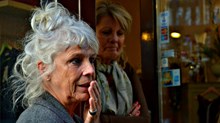How Do I Explain Easter to My Children?
I don't know how to explain Easter to my children—Penny, 5, and William, 2. I've tried two approaches.
I've talked about it directly: "Some people killed Jesus and he died and God made him alive again."
"What does died mean?" William asked.
I tried to explain death as something that takes people away forever.
"Where is Jesus now?" Penny asked.
"Jesus is in heaven and all around us," I said.
"But where is Jesus now?"
Then Penny went to Sunday school last week, where her teachers reenacted the Passion of Jesus. I was sitting in church when, halfway through the sermon, one of the teachers brought Penny to me. She sat by my side, coloring, for the rest of the service. Her teacher later explained that when Penny had seen Jesus nailed to the cross, she stood to leave.
I asked Penny later, "What happened in Sunday school? Did you learn something about Jesus?"
Without looking at me she said, "He died. I needed to see you, Mom."
"Do you know what happened when he died?"
"I don't want to talk about it."
The direct route didn't get us far.
I've also tried the indirect approach: "Do you know what Easter is all about?" I asked William.
His eyes lit up. "Bunnies!"
"Well, kind of."
I understood his confusion. He came home from preschool with Easter eggs. A man at the coffee shop gave him a chocolate bunny. And we have an "Easter tree" on our kitchen table, with forsythia in bloom and painted wooden eggs dangling from the branches.
I thought maybe I could explain Easter using springtime symbols, and we could talk about death and rebirth, about caterpillars and butterflies or chicks hatching or crocuses in bloom.
But the analogies fall apart quickly. First, nothing in the natural world is brought from death to life. What's dead stays dead. Furthermore, suggesting that the Cross and the Empty Tomb are just like the daffodils threatens to cheapen our faith and hope in Christ.
In Practice
One reason I have trouble explaining Easter to my children is that I have trouble explaining it to myself. Even the New Testament writers couldn't find adequate words or images to explain what happened that weekend in Jerusalem. While the facts remain easy—Jesus died on the cross, and God raised him from the dead—understanding the significance of those facts remains a challenge.
Again and again, New Testament writers describe the impact of Jesus' death and resurrection as a "mystery." In Paul's long defense of the Resurrection's reality, he concludes: "Let me reveal to you a wonderful secret. We will not all die, but we will all be transformed! It will happen in a moment, in the blink of an eye, when the last trumpet is blown. For when the trumpet sounds, those who have died will be raised to live forever. And we who are living will also be transformed" (1 Corinthians 15:51-52). In Ephesians, we read of the "mystery of God's will" in reconciling all things through Christ (Ephesians 1:9) and "the mystery of the gospel" (Ephesians 6:19). In Colossians 1:27, we read that the "mystery" is "Christ in you, the hope of glory."
Christians believe that Jesus' death was more than martyrdom, that it actually effected forgiveness of sins and reconciliation between God and humanity. The Resurrection bolsters that faith as God's validation of Jesus' willing self-sacrifice. And yet, as liturgical traditions assert, when we describe the events of Holy Week, we proclaim the mystery of our faith: Christ has died. Christ is risen. Christ will come again.
I don't mean to dismiss the intelligibility of our faith or imply that it cannot be explained in words. But I'm not going to worry if my words fail to convey the message of Easter to our children. Instead, I look for ways that our practices convey the message of sin and salvation, brokenness and healing, rupture and forgiveness, death and resurrection.
Our children will witness those concepts in real life, I hope, when they watch their parents snap at each other and then reconcile, or when they receive a hug after they have misbehaved, or when they hear us talk about our hope of seeing their deceased grandmother once again. They will also enact these concepts as they participate in the life of the church.
As it happened, last Sunday was communion Sunday. Because Penny excused herself from witnessing the crucifixion in Sunday school, she unwittingly invited herself to the Lord's Table. Together we walked to the front. She tasted the bread and the juice and watched me do the same. I don't know how much she heard when our pastor read the story of the Last Supper. I don't know if she noticed that we partook of those elements in front of a wooden cross. But I know she practiced remembering Jesus' death and resurrection as a part of the body of Christ. She participated in the final song, raising her hands in the air and singing "My Jesus, My Savior."
On Easter Sunday, my children will not be able to explain the meaning of death and resurrection. But I have faith that they will participate in the faith and hope that come from Jesus' gift of new life.
Read more articles that highlight writing by Christian women at ChristianityToday.com/Women
 Read These Next
Read These Next
 Fearing GodHow do we reconcile the approachability of his love with the terror of his holiness?
Fearing GodHow do we reconcile the approachability of his love with the terror of his holiness?


 Where Have All the Gray-Haired Ladies Gone?Embracing age in a youth-obsessed culture
Where Have All the Gray-Haired Ladies Gone?Embracing age in a youth-obsessed culture








 Homepage
Homepage